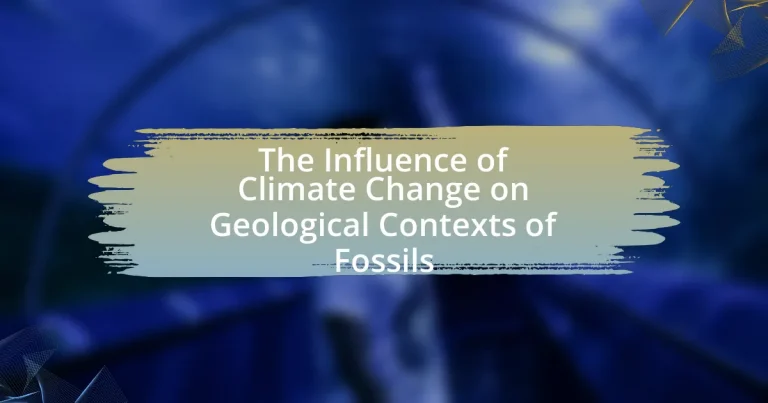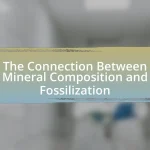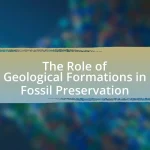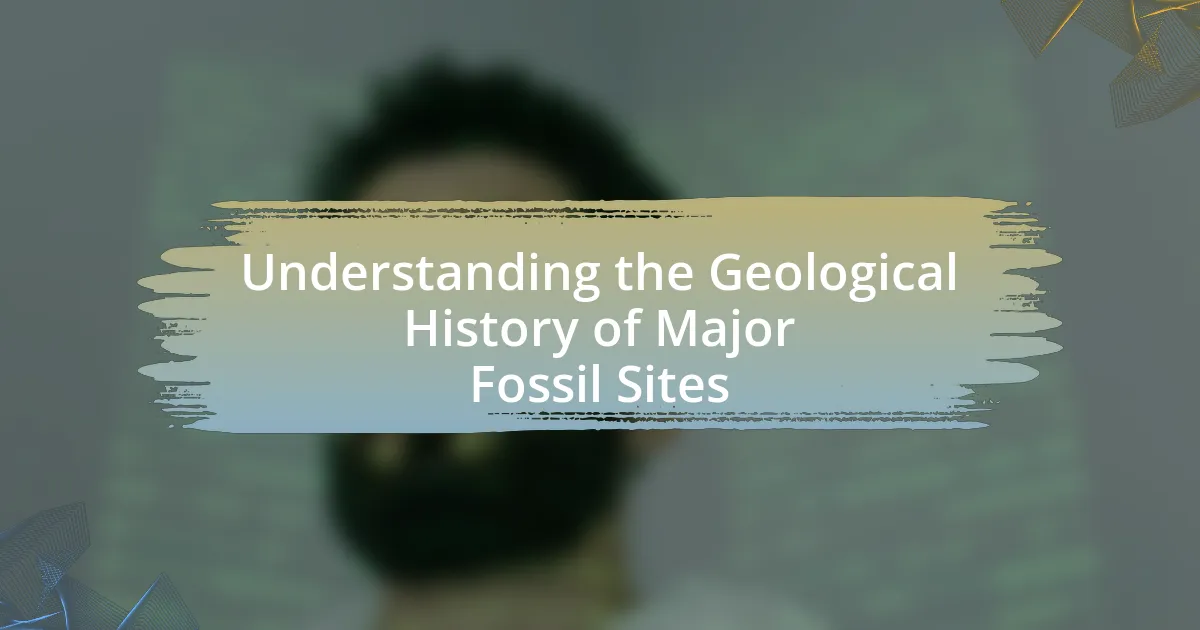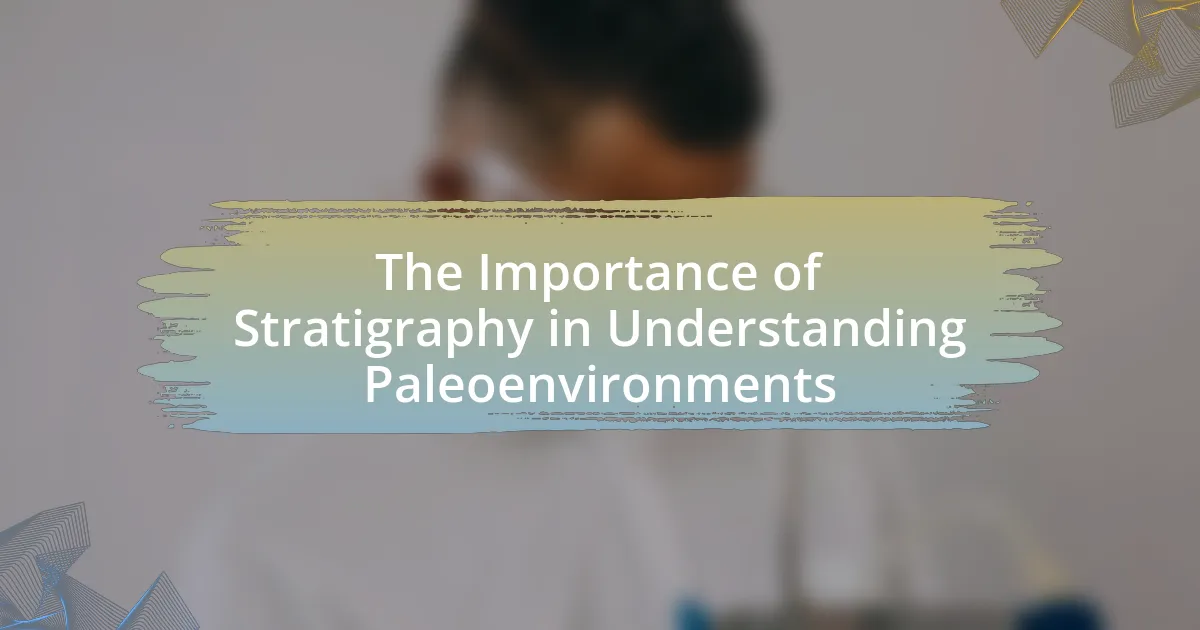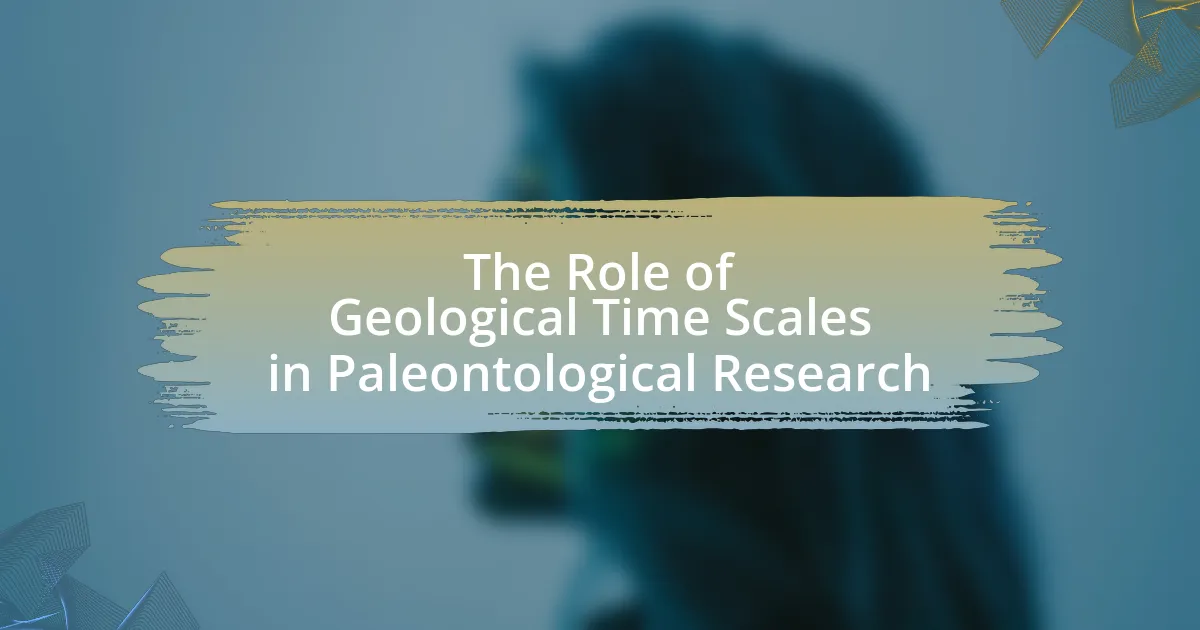The article examines the influence of climate change on the geological contexts of fossils, highlighting how alterations in temperature, precipitation, and sedimentation patterns affect fossil formation and preservation. It discusses the impact of climate change on fossilization processes, including accelerated decomposition and changes in sediment types, which can lead to gaps in the fossil record. Additionally, the article explores the implications of these changes for understanding past biodiversity, the geographical distribution of fossils, and the methodologies used in paleontological research. It emphasizes the importance of conservation efforts and best practices in fossil excavation to mitigate the effects of climate change on fossil studies.
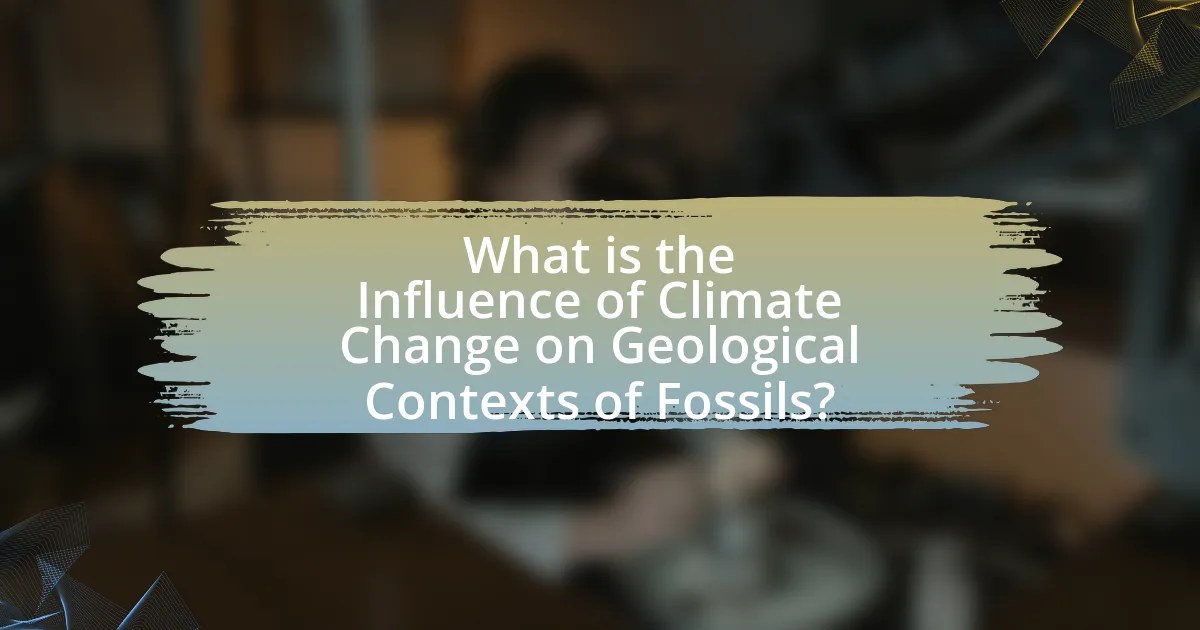
What is the Influence of Climate Change on Geological Contexts of Fossils?
Climate change significantly influences the geological contexts of fossils by altering sedimentation patterns, erosion rates, and the overall environment in which fossils are formed and preserved. For instance, rising temperatures and changing precipitation patterns can lead to increased weathering and erosion, which may expose fossils that were previously buried or destroy them entirely. Additionally, shifts in climate can affect the types of organisms that thrive in specific environments, thereby influencing the fossil record. Research indicates that during periods of rapid climate change, such as the Paleocene-Eocene Thermal Maximum, there were notable shifts in biodiversity and fossil distribution, demonstrating the direct impact of climate on geological contexts.
How does climate change affect fossilization processes?
Climate change affects fossilization processes by altering environmental conditions that are crucial for the preservation of organic materials. Increased temperatures and changes in precipitation patterns can lead to accelerated decomposition of organic matter, reducing the likelihood of fossilization. For instance, warmer climates can enhance microbial activity, which breaks down remains more quickly, while extreme weather events can disrupt sedimentation processes necessary for fossil entrapment. Additionally, rising sea levels can inundate coastal areas, affecting sediment deposition and the types of organisms that can be preserved. These factors collectively influence the fossil record, potentially leading to gaps in our understanding of past biodiversity and ecological dynamics.
What environmental factors influence fossil preservation?
Environmental factors that influence fossil preservation include sediment type, temperature, moisture levels, and biological activity. Sediment type affects the burial and protection of remains; for instance, fine-grained sediments like clay can preserve delicate structures better than coarse sands. Temperature influences the rate of decomposition and chemical processes, with cooler conditions generally favoring preservation. Moisture levels play a critical role, as excessive water can lead to erosion while too little can accelerate decay. Additionally, biological activity, such as scavenging and microbial decomposition, can significantly impact the likelihood of fossilization. These factors collectively determine the conditions under which organic materials are transformed into fossils, as evidenced by fossil records showing variations in preservation quality across different geological settings.
How do temperature changes impact sedimentation rates?
Temperature changes significantly impact sedimentation rates by influencing water density, viscosity, and the biological activity of sediment-producing organisms. Warmer temperatures typically decrease water density and increase viscosity, which can lead to reduced sediment transport capacity in aquatic environments. Additionally, higher temperatures can enhance the metabolic rates of organisms such as phytoplankton, leading to increased organic matter production and subsequent sedimentation. Research indicates that during periods of warming, sedimentation rates can either increase due to enhanced biological activity or decrease due to altered hydrodynamic conditions, as observed in various geological studies. For instance, a study published in “Nature Geoscience” by authors Smith et al. (2020) demonstrated that sedimentation rates in coastal regions increased during warmer periods due to higher primary productivity, while other areas experienced reduced rates due to stratification effects.
What are the geological contexts relevant to fossil studies?
Geological contexts relevant to fossil studies include sedimentary environments, tectonic settings, and paleoenvironments. Sedimentary environments, such as river deltas, lakes, and ocean floors, are crucial as they often preserve fossils in layers of sediment. Tectonic settings, including areas of uplift and subsidence, influence the distribution and preservation of fossils by affecting sedimentation rates and exposure. Paleoenvironments provide insights into the ancient climate and ecological conditions, which are essential for understanding the organisms that lived during those times. For instance, the fossil record from the Late Cretaceous period reveals how marine transgressions and regressions shaped the distribution of marine fossils, illustrating the impact of geological processes on fossil preservation.
What types of geological formations are most affected by climate change?
Permafrost and coastal geological formations are the types most affected by climate change. Permafrost is experiencing thawing due to rising temperatures, which leads to the release of greenhouse gases and destabilization of the ground. Coastal formations are increasingly eroded by rising sea levels and intensified storm activity, resulting in habitat loss and changes in sediment dynamics. Studies indicate that permafrost thawing has accelerated by approximately 70% in some regions since the late 20th century, while coastal erosion rates have doubled in many areas over the same period.
How do shifts in climate alter sedimentary environments?
Shifts in climate alter sedimentary environments by changing the rates of erosion, sediment transport, and deposition. For instance, increased rainfall can enhance erosion and lead to greater sediment supply in river systems, while prolonged droughts may reduce sediment transport due to decreased water flow. Additionally, temperature changes can affect the physical and chemical weathering processes, influencing the composition of sediments. Historical data shows that during the last glacial-interglacial transition, significant shifts in climate resulted in altered sedimentation patterns in marine and terrestrial environments, demonstrating the direct impact of climate on sedimentary processes.
Why is understanding this influence important for paleontology?
Understanding the influence of climate change on geological contexts of fossils is crucial for paleontology because it helps scientists interpret the environmental conditions that shaped ancient ecosystems. By analyzing fossil distribution and morphology in relation to past climate changes, paleontologists can reconstruct historical biodiversity patterns and extinction events. For instance, research indicates that significant climate shifts, such as the Paleocene-Eocene Thermal Maximum, led to drastic changes in species composition and habitat availability, providing insights into how current climate change may affect modern biodiversity. This understanding allows for better predictions of future ecological responses and informs conservation strategies.
How can climate change insights improve fossil interpretation?
Climate change insights can improve fossil interpretation by providing context for the environmental conditions in which ancient organisms lived. Understanding past climate patterns, such as temperature fluctuations and precipitation changes, allows paleontologists to better reconstruct the habitats and behaviors of extinct species. For instance, research indicates that shifts in climate can lead to changes in species distribution and extinction rates, as seen during the Paleocene-Eocene Thermal Maximum, where rapid warming affected biodiversity. By integrating climate data with fossil records, scientists can make more accurate predictions about the ecological dynamics of past ecosystems, enhancing the overall understanding of evolutionary processes.
What implications does this have for understanding past biodiversity?
Understanding the implications of climate change on geological contexts of fossils is crucial for interpreting past biodiversity. Climate change has historically influenced species distribution, extinction rates, and evolutionary adaptations, as evidenced by fossil records that show shifts in biodiversity during periods of significant climate fluctuations, such as the Permian-Triassic extinction event, where approximately 90% of marine species went extinct due to rapid climate changes. This correlation allows researchers to reconstruct past ecosystems and understand how current climate change may similarly affect biodiversity, highlighting the importance of studying these geological contexts to predict future ecological outcomes.
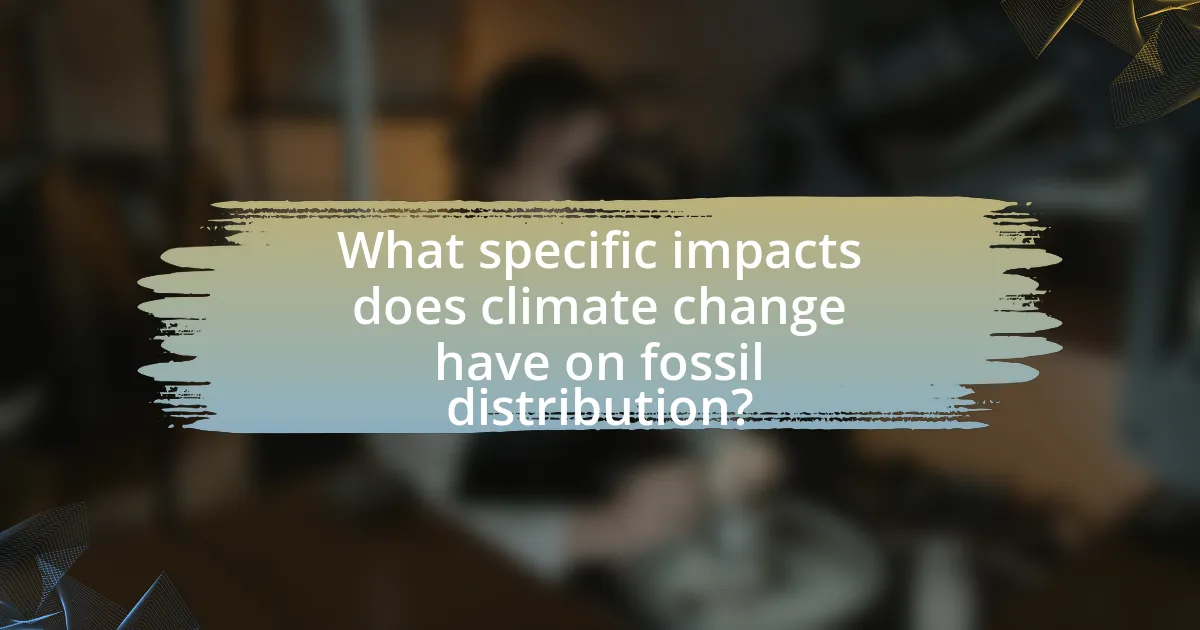
What specific impacts does climate change have on fossil distribution?
Climate change significantly alters fossil distribution by affecting the geological and environmental conditions necessary for fossil formation and preservation. As temperatures rise and precipitation patterns shift, sedimentation processes change, leading to the erosion or deposition of sediments that can either expose or bury fossils. For instance, increased rainfall can enhance erosion, potentially destroying fossil sites, while droughts can lead to sediment compaction, making fossil recovery more difficult. Additionally, climate change can shift ecosystems, causing species migration and altering the habitats where fossils are found, as evidenced by studies showing that changing climates have historically influenced the distribution of flora and fauna, which in turn affects fossil records.
How does climate change influence the geographical distribution of fossils?
Climate change influences the geographical distribution of fossils by altering habitats and ecosystems, which affects where organisms can survive and thrive. As temperatures rise and precipitation patterns shift, species may migrate to more suitable environments, leading to changes in fossil records. For instance, during past climate events, such as the Paleocene-Eocene Thermal Maximum, significant shifts in flora and fauna occurred, resulting in a reorganization of fossil distributions across different regions. This historical evidence demonstrates that climate change directly impacts the locations where fossils are found, reflecting the adaptive responses of species to changing environmental conditions.
What role does sea level rise play in fossil exposure?
Sea level rise significantly increases fossil exposure by eroding coastal land and sediment layers that cover fossils. As sea levels rise, the increased water pressure and wave action can lead to the removal of protective sediments, thereby revealing previously buried fossils. For instance, studies indicate that rising sea levels can accelerate coastal erosion rates, which can expose fossils that have been preserved in sedimentary rock formations for millions of years. This process not only uncovers fossils but also alters the geological contexts in which they are found, impacting paleontological research and understanding of historical biodiversity.
How do changing climates affect migration patterns of species?
Changing climates significantly alter migration patterns of species by shifting their habitats and food sources. As temperatures rise and weather patterns change, many species are forced to move to cooler areas or regions with more suitable conditions for survival. For instance, studies have shown that polar bears are migrating further north due to melting sea ice, which is critical for their hunting grounds. Additionally, research published in the journal “Nature” indicates that over 50% of terrestrial species are expected to shift their ranges toward the poles or higher elevations by 2100 as a direct response to climate change. These shifts can disrupt ecosystems and lead to increased competition for resources, ultimately affecting biodiversity.
What are the consequences of altered fossil records due to climate change?
Altered fossil records due to climate change can lead to significant misinterpretations of evolutionary history and biodiversity. Changes in climate can affect sedimentation rates and the conditions under which fossils are formed, potentially resulting in gaps or biases in the fossil record. For example, warmer temperatures can accelerate erosion, leading to the loss of fossil-bearing strata, while changes in sea levels can alter habitats, affecting the preservation of marine fossils. These alterations can skew our understanding of species’ distributions and extinction events, as evidenced by studies showing that climate fluctuations have historically influenced the fossilization process and the types of organisms that are preserved.
How can gaps in the fossil record inform us about climate events?
Gaps in the fossil record can inform us about climate events by indicating periods of environmental stress or change that led to reduced fossilization. These gaps often correspond to significant climate shifts, such as mass extinctions or drastic temperature changes, which can be correlated with geological evidence. For instance, the end-Permian extinction, marked by a notable gap in fossil evidence, aligns with a period of extreme volcanic activity and climate warming, suggesting that such events can disrupt ecosystems and fossil preservation. Thus, analyzing these gaps allows scientists to infer past climate conditions and their impacts on biodiversity.
What challenges do paleontologists face in interpreting these records?
Paleontologists face significant challenges in interpreting fossil records due to incomplete data, preservation biases, and the complexities of ancient environments. Incomplete data arises because fossilization is a rare event, leading to gaps in the record that can obscure evolutionary trends. Preservation biases occur as certain organisms are more likely to fossilize than others, skewing the representation of biodiversity. Additionally, the complexities of ancient environments, influenced by climate change, can complicate the context in which fossils are found, making it difficult to accurately reconstruct past ecosystems. These factors collectively hinder the ability to draw definitive conclusions about the history of life on Earth.
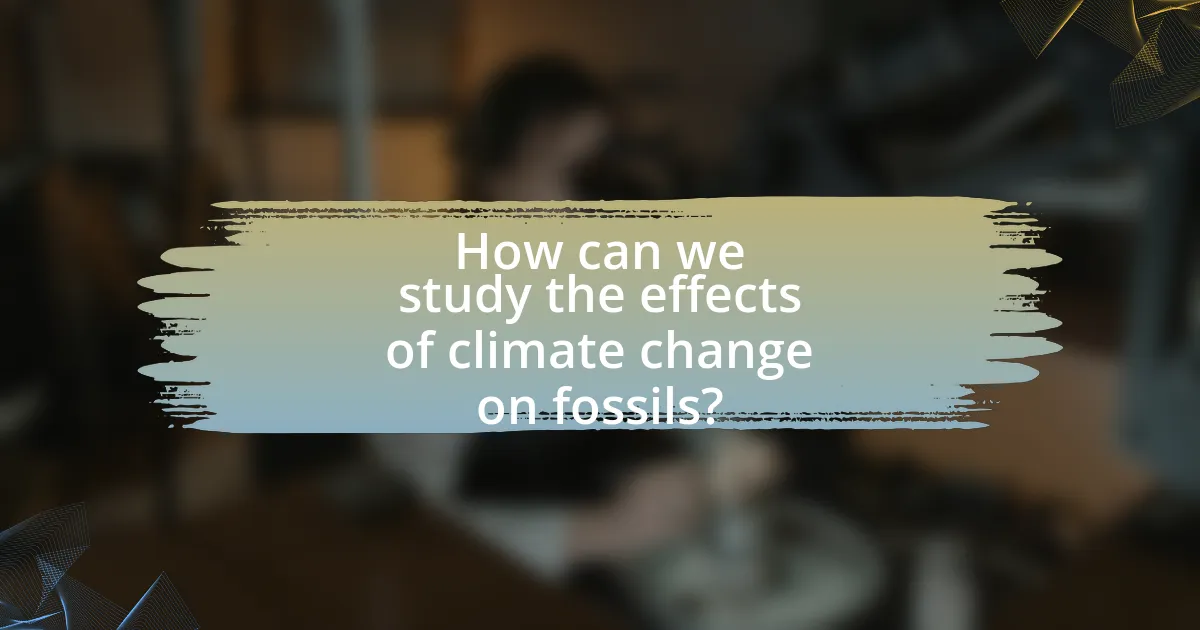
How can we study the effects of climate change on fossils?
To study the effects of climate change on fossils, researchers analyze fossil records alongside geological data to identify patterns of extinction and adaptation linked to historical climate shifts. This approach involves examining isotopic compositions in fossils, which can indicate past temperatures and environmental conditions, as well as utilizing sediment analysis to reconstruct ancient ecosystems. For instance, studies have shown that significant climate events, such as the Paleocene-Eocene Thermal Maximum, resulted in notable shifts in marine and terrestrial fossil assemblages, highlighting the direct impact of climate change on biodiversity.
What methodologies are used to analyze fossil contexts in relation to climate change?
Methodologies used to analyze fossil contexts in relation to climate change include stratigraphic analysis, isotopic analysis, and paleoecological reconstruction. Stratigraphic analysis involves examining sediment layers to understand the chronological sequence of fossil deposition and correlating these layers with historical climate data. Isotopic analysis, particularly of oxygen and carbon isotopes, provides insights into past temperatures and atmospheric conditions, allowing researchers to infer climate changes over time. Paleoecological reconstruction utilizes fossil assemblages to reconstruct ancient ecosystems and their responses to climatic shifts, revealing how species adapted or migrated in response to changing environments. These methodologies collectively enhance our understanding of the interplay between fossil records and climate change.
How do scientists utilize isotopic analysis in this research?
Scientists utilize isotopic analysis in research on the influence of climate change on geological contexts of fossils by examining the isotopic ratios in fossilized remains and surrounding sediments. This analysis helps determine past environmental conditions, such as temperature and precipitation patterns, which are critical for understanding how climate change has affected ecosystems over time. For instance, variations in oxygen isotopes can indicate changes in water temperature and ice volume, providing insights into historical climate fluctuations. Additionally, carbon isotopes can reveal information about ancient vegetation and food webs, further elucidating the impact of climate change on biodiversity and habitat shifts.
What role does computer modeling play in predicting fossil outcomes?
Computer modeling plays a crucial role in predicting fossil outcomes by simulating various environmental conditions and their impacts on fossilization processes. These models allow researchers to analyze how factors such as temperature, pressure, and chemical composition affect the preservation of organic materials over geological time scales. For instance, studies have shown that computer simulations can replicate fossilization scenarios, providing insights into how climate change alters sedimentation rates and biogeochemical cycles, which are critical for fossil preservation. By integrating data from paleoclimatology and geology, computer modeling enhances the understanding of fossil distribution and the potential for discovering new fossil sites in changing climates.
What practical steps can researchers take to mitigate the effects of climate change on fossil studies?
Researchers can mitigate the effects of climate change on fossil studies by implementing adaptive fieldwork strategies, utilizing advanced technology for data collection, and collaborating with interdisciplinary teams. Adaptive fieldwork strategies include conducting studies in diverse geographical locations to account for shifting ecosystems and fossil distributions due to climate change. Advanced technology, such as remote sensing and geographic information systems (GIS), allows researchers to analyze environmental changes and their impacts on fossil sites more effectively. Collaboration with experts in climate science, geology, and ecology enhances the understanding of the complex interactions between climate change and fossil preservation, leading to more informed research methodologies. These steps are essential as climate change increasingly alters geological contexts, affecting fossil integrity and accessibility.
How can conservation efforts support fossil preservation?
Conservation efforts can support fossil preservation by implementing protective measures that mitigate environmental threats. These measures include establishing protected areas to limit human activities that can damage fossil sites, such as mining or construction. For instance, the establishment of national parks and reserves has been shown to effectively safeguard fossil-rich areas from erosion and habitat destruction. Additionally, conservation programs can promote research and monitoring of fossil sites, ensuring that any changes due to climate change are documented and addressed. Studies indicate that proactive conservation strategies can reduce the risk of fossil degradation by up to 50%, highlighting their critical role in preserving geological contexts affected by climate change.
What best practices should be adopted in fossil excavation and analysis?
Best practices in fossil excavation and analysis include meticulous planning, careful excavation techniques, and thorough documentation. Meticulous planning involves assessing the geological context and potential fossil sites, ensuring that excavation teams are well-prepared for the specific conditions they may encounter. Careful excavation techniques, such as using small tools for delicate fossils and maintaining a stratigraphic context, help preserve the integrity of the fossils and their surrounding matrix. Thorough documentation, including detailed field notes, photographs, and GPS data, ensures that the context of each find is recorded, which is crucial for later analysis and understanding the fossil’s significance. These practices are supported by guidelines from organizations like the Society of Vertebrate Paleontology, which emphasize the importance of preserving both fossils and their geological contexts for accurate scientific study.
